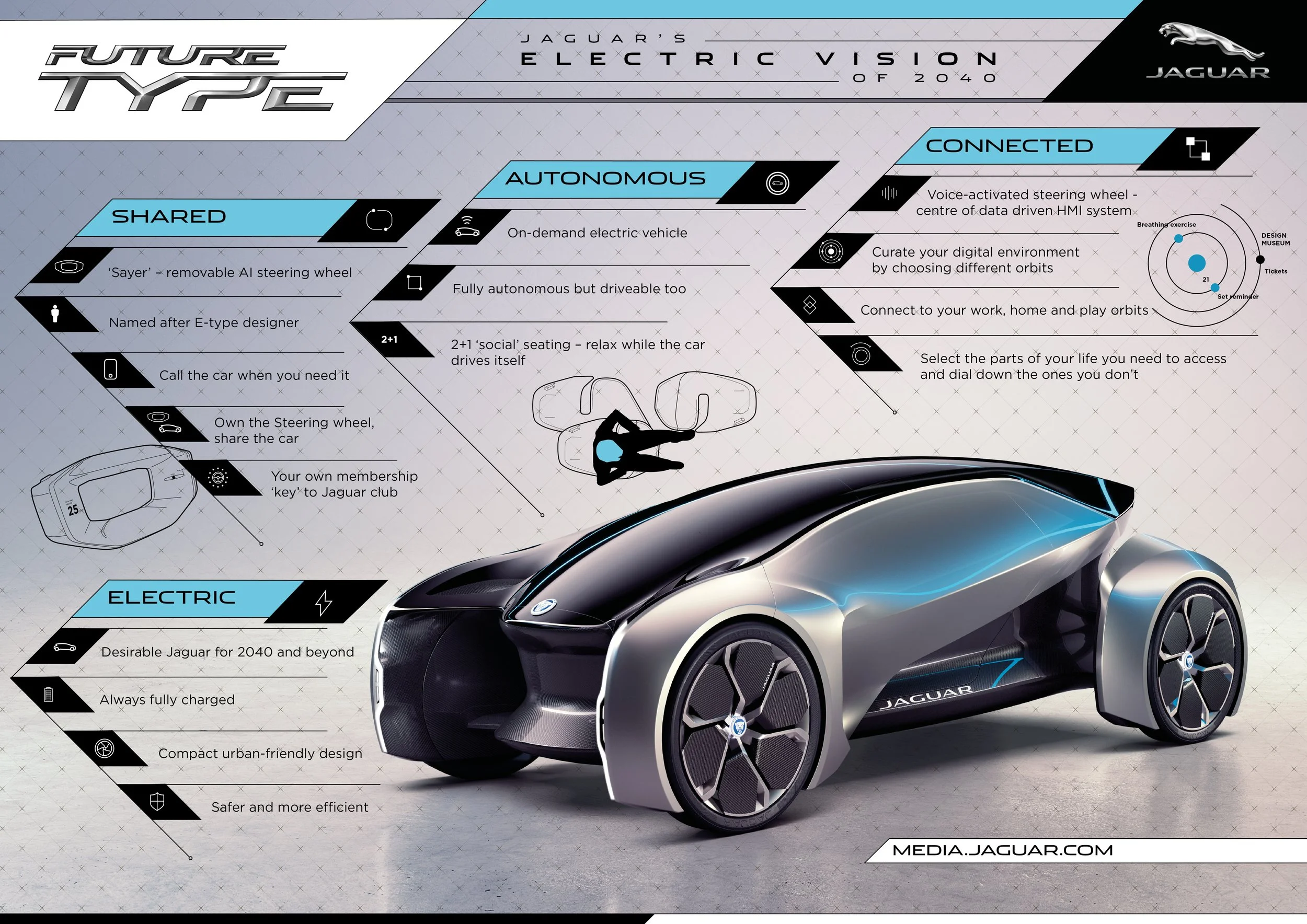Living with the now discontinued IPace
Before looking to the present and the future I want to start by looking at the past Jaguar’s 2017 electric ambitions *2 of a electric E-type, AI steering wheel, autonomous and connected vision.
Jaguar’s electric vision of 2040
That vision quite deliberately lacks any plans for practicalities to do with charging, smart home integration, solar, carbon costs, motorway fast charging, etc, these are more practical considerations that only now 8 years later JLR is finally pursuing *3 in their pilot plan with ev.energy, never mind a battery swapping/recycling strategy, lets hope it does not take another 8 years for the plans around that to take shape.
The ongoing work on retooling the 61-year-old factory in Halewood, Merseyside *5, for the electric age could take years and there is no timeline for the Gravity gigafactory being built by JLR’s parent company, TATA, in the UK at Bridgwater *6. This gigafactory is a £4 billion project that TATA is undertaking through its new global battery business, Agratas. is not looking too good, with only groundworks completed as of August 2024 when I last took this drone photo.
Tata Agratas Gravity gigafactory in Somerset is planed to scale up to 40 GW and span over 300 acres but there are not timelines
Maybe Jaguar is not to blame, the beginning of the end started with LG Chem and an increasing amount of shorts and fires in battery modules it supplied starting 2017 exhibiting a flaw that has come to be known as a “folded anode tab“
In July 2024, Jaguar Land Rover (JLR) confirmed that the I‑Pace—as well as several other Jaguar models—were “delivering close to zero profitability” arguably this was a chief reason for the discontinuation and strategy shift to more expensive lower volume electric only models, what also did not help were the myriad of problems stemming from LG Chem’s Ochang, South Korea plant (and others) producing defective pouch cells with folded or torn anode tabs and separators, production was halted in 2021 but it goes back to 2017 with other automakers like GM and Hyundai affected and the supposedly last recall being as recent as 2025.
lg chem folded anode tab
Jaguar I-Pace Battery recall list: H441, H459, H484, H514
The top 5 issues with the Jaguar I-Pace
The Jaguar I-Pace was introduced in 2018 and by the time it was discontinued in 2024 it sold around 66k units, for context Tesla sells as many cars in 2 weeks, BYD just in one week. Resale value plummeted as it was discontinued, according to electrek it’s only second to the Audi Q8
This projected future of the I-Paces on the road and resale value based on 4.5% per year attrition model of industry scrap/survival rates
So there aren’t loads of I-Paces on the market and for Jaguar to keep having to service, with 2k dealerships worldwide, assuming all of these 66k are still on the roads, that’s one dealership for ever 26 cars, moving forward however the UK is on the way down to 20 dealers from 80, in the USA down to 120 from 200 *1
This scale-down points to a future where independent Jaguar specialists will be increasingly seeing a demand for their custom from I-Pace owners. I spoke with a few in the UK.
Some have been shunning these newfangled electric owners coming their way altogether and doubled down on their focus on petrol classics, which is understandable considering the vast differences and the need for a shift from mechanics to software diagnostic specialists.
Others have starting investing in the training needed, the services and the tooling, it will be interesting if this develops into a slid support network for what is soon to be a growing fleet of 100k mile plus I-Paces needing maintenance out of warranty.
JLR TOPIx is a web based system where for a cost both franchised repairers who have a DSL-ID or CDS-ID and independent repairs can get access to manuals, live vehicle status, module update facilities etc,
TL/DR : Surprised that JLR is cutting 500 management jobs in the UK, delaying their new electric cars, lying about there being no demand when the reality is the JLR ecosystem and the manufacturing won’t be ready for years … not really, worried about the future of the I-Paces on the road, definitely.
2020 I-Pace HSE with over 100K miles







